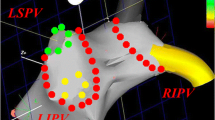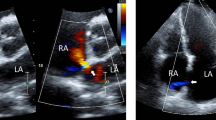Abstract
Purpose
Our goal was to evaluate acute effects of left atrial lesion formation and volume overload on hemodynamics during pulmonary vein antrum isolation (PVAI) as it might be a potential cause of acute pulmonary edema.
Methods
In consecutive patients presenting for PVAI, open irrigation ablation was performed (50 W, 48°C, 15 s lesion duration, saline flow rate 30 mL/min). Blood samples were drawn from the left atrium and the pulmonary artery immediately before and 30 min after PVAI. The cardiac output (CO) and stroke volume (SV) were calculated by the method of Fick.
Results
We included 61 (27 female, 61 ± 11 years) patients suffering from paroxysmal (px; 33) or persistent (per; 28) atrial fibrillation (AF) in this study. A total of 2,917 ± 242 mL of volume was infused (2,651 ± 223 mL pxAF vs. 3,184 ± 255 mL perAF, (p < 0.01)). Total ablation time was 60 ± 7 min (52 ± 7 min in pxAF vs. 69 ± 8 min in perAF; (p < 0.001)). CO increased from 5.2 ± 1.3 to 6.2 ± 1.5 L/min (p < 0.001) during PVAI (5.7 ± 1.3 to 6.5 ± 1.7 L/min in pxAF; (p < 0.002) and 4.8 ± 1.1 to 5.9 ± 1.2 L/min in perAF; (p < 0.001)). SV increased from 74 ± 24 to 83 ± 21 mL (p < 0.005) during PVAI, and subgroups showed an increase of 82 ± 23 to 88 ± 22 mL in pxAF (p < 0.009) and 62 ± 21 to 76 ± 16 mL in perAF (p < 0.009).
Conclusions
From our preliminary experience, left atrial scarring and volume overload during PVAI do not seem to impact negatively hemodynamics. On the contrary, an improvement in cardiac output was documented acutely independent of type of AF.


Similar content being viewed by others
Abbreviations
- AF:
-
Atrial fibrillation
- CO:
-
Cardiac output
- LA:
-
Left atrium
- Per:
-
Permanent
- PV:
-
Pulmonary vein
- PVAI:
-
Pulmonary vein antrum isolation
- Px:
-
Paroxysmal
- SV:
-
Stroke volume
References
Fuster, V., Ruyden, L. E., Cannom, D. S., Crijns, H. J., Curtis, A. B., Ellenbogen, K. A., et al. (2006). ACC/AHA/ESC 2006 Guidelines for the management of patients with atrial fibrillation: A Report of the American College of Cardiology/American Heart Association Task Force on Practice Guidelines and the European Society of Cardiology Committee for Practice Guidelines (Writing Committee to Revise the 2001 Guidelines for the Management of Patients With Atrial Fibrillation): Developed in Collaboration With the European Heart Rhythm Association and the Heart Rhythm Society. Circulation, 114, 700–752.
Camm, A.J., Kirchhof, P., Lip, G.Y.H., Schotten, U., Savelieva, I., Ernst, S., et al. (2010). Guidelines for the management of atrial fibrillation. The Task Force for the Management of Atrial Fibrillation of the European Society of Cardiology (ESC). Developed with the special contribution of the European Heart Rhythm Association (EHRA) Endorsed by the European Association for Cardio-Thoracic Surgery (EACTS) European Heart Journal 31, 2369–2429
Verma, A., Marrouche, N. F., & Natale, A. (2004). Pulmonary vein antrum isolation: intracardiac echocardiography-guided technique. Journal of Cardiovascular Electrophysiology, 15, 1335–1340.
Haïssaguerre, M., Jais, P., Shah, D. C., Takahashi, A., Hocini, M., Quiniou, G., et al. (1998). Spontaneous initiation of atrial fibrillation by ectopic beats originating in the pulmonary veins. The New England Journal of Medicine, 339, 659–666.
Chen, S. A., Hsieh, M. H., Tai, T. C., Tsai, C. F., Prakash, V. S., Yu, W. C., et al. (1999). Initiation of atrial fibrillation by ectopic beats originating from the pulmonary veins. Circulation, 100, 1879–1886.
Haïssaguerre, M., Jaïs, P., Shah, D. C., Garrigue, S., Takahashi, A., Lavergne, T., et al. (2000). Electrophysiological end point for catheter ablation of atrial fibrillation initiated from multiple pulmonary venous foci. Circulation, 101, 1409–1417.
Haïssaguerre, M., Jaïs, P., Shah, D. C., Arentz, T., Kalusche, D., Takahashi, A., et al. (2000). Catheter ablation of chronic atrial fibrillation targeting the reinitiating triggers. Journal of Cardiovascular Electrophysiology, 11, 2–10.
Pappone, C., Rosanio, S., Oreto, G., Tocchi, M., Gugliotta, F., Vicedomini, G., et al. (2000). Circumferential radiofrequency ablation of pulmonary vein ostia: a new anatomic approach for curing atrial fibrillation. Circulation, 102, 2619–2628.
Nademanee, K., McKenzie, J., Kosar, E., Schwab, M., Sunsaneewitayakul, B., Vasavakul, T., et al. (2004). A new approach for catheter ablation of atrial fibrillation: mapping of the electrophysiologic substrate. Journal of the American College of Cardiology, 43, 2044–2053.
Oral, H., Pappone, C., Chugh, A., Good, E., Bogun, F., Pelosi, F., et al. (2006). Circumferential pulmonary-vein ablation for chronic atrial fibrillation. The New England Journal of Medicine, 354, 934–939.
Yamane, T., Date, T., Kanzaki, Y., Inada, K., Matsuo, S., Shibayama, K., et al. (2007). Segmental pulmonary vein antrum isolation using the “large-size” lasso catheter in patients with atrial fibrillation. Circulation Journal, 71, 753–760.
Arentz, T., Weber, R., Bürkle, G., Herrera, C., Blum, T., Stockinger, J., et al. (2007). Small or large isolation areas around the pulmonary veins for the treatment of atrial fibrillation? Results from a prospective randomized study. Circulation, 115, 3057–3063.
Kanj, M. H., Wazni, O., Fahmy, T., Thal, S., Patel, D., Elay, C., et al. (2007). Pulmonary vein antral isolation using an open irrigation ablation catheter for the treatment of atrial fibrillation: a randomized pilot study. Journal of the American College of Cardiology, 49, 1634–1641.
McGann, C. J., Kholmovski, E. G., Oakes, R. S., Blauer, J. J., Daccarett, M., Segerson, N., et al. (2008). New magnetic resonance imaging-based method for defining the extent of left atrial wall injury after the ablation of atrial fibrillation. Journal of the American College of Cardiology, 52, 1263–1271.
Marrouche, N. F., Guenther, J., Segerson, N. M., Daccarett, M., Rittger, H., Marschang, H., et al. (2007). Randomized comparison between open irrigation technology and intracardiac-echo-guided energy delivery for pulmonary vein antrum isolation: procedural parameters, outcomes, and the effect on esophageal injury. Journal of Cardiovascular Electrophysiology, 18, 583–588.
Singh, S. M., d’Avila, A., & Reddy, V. Y. (2009). Congestive heart failure after atrial fibrillation ablation. Europace, 11, 272.
Khan, M. N., Jaïs, P., Cummings, J. E., Di Biase, L., Sanders, P., Martin, D. O., et al. (2008). Pulmonary-vein isolation for atrial fibrillation in patients with heart failure. The New England Journal of Medicine, 359, 1778–1785.
Hsu, L. F., Jaïs, P., Sanders, P., Garrigue, S., Hocini, M., Sacher, F., et al. (2004). Catheter ablation for atrial fibrillation in congestive heart failure. The New England Journal of Medicine, 351, 2373–2383.
Krakau, I. (1999). Das Herzkatheterbuch. Diagnostische und interventionelle Herzkathetertechniken. Stuttgart: Thieme.
Warren, J. V., Staed, E. A., & Brannon, E. S. (1946). The cardiac output in man: a study of some of the errors in the method of right heart catheterization. The American Journal of Physiology, 145, 458–464.
Morris, J. J., Entman, M., North, W. C., Kong, Y., & McIntosh, H. (1965). The changes in cardiac output with reversion of atrial fibrillation to sinus rhythm. Circulation, 31, 670–678.
Disclosures
Dr. Nölker received financial support for presentation of study data from Biosense Webster and Boston Scientific.
Author information
Authors and Affiliations
Corresponding author
Rights and permissions
About this article
Cite this article
Nölker, G., Gutleben, K.J., Ritscher, G. et al. Left atrial lesion formation and volume overload by open irrigation ablation technology during pulmonary vein antrum isolation: acute effects on cardiac hemodynamics. J Interv Card Electrophysiol 31, 125–130 (2011). https://doi.org/10.1007/s10840-011-9545-5
Received:
Accepted:
Published:
Issue Date:
DOI: https://doi.org/10.1007/s10840-011-9545-5




